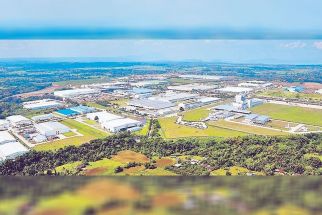Preparing for bigger storms

It’s been 13 years since Tropical Storm Ondoy (international name Ketsana) caused widespread flooding in Metro Manila, paralyzing life for many of the metro’s residents whose homes stood in slowly receding waters for weeks.
The heavy all-day downpour last Saturday by Severe Tropical Storm Paeng (Nalgae) momentarily brought back some of the angst that comes when typhoons hit Metro Manila. This time, though, Paeng was to pass through within 24 hours, unlike Ondoy that stayed stationary over the metro for days.
Metro Manila, officially known as the National Capital Region (NCR), is home to over 13 million Filipinos, packed ever so densely in 636 square kilometers of land space. Flooding is a perennial problem, especially in its low-lying cities, although even other areas can experience inundations if their flood control infrastructure and systems are not properly maintained.
One of the biggest lessons learned from Ondoy was the need for a national agency responsible for ensuring the protection and welfare of Filipinos during disasters or emergencies. In 2010, the Disaster Risk Reduction and Management Act was swiftly passed.
Since then, and with the assistance of numerous international agencies, the Philippines has built a formidable network of public and private institutions and bodies that actively interact with each other through the National Disaster Risk Reduction Management Council (NDRRMC).
Perhaps the biggest gain that comes with the passage of the law is the heightened awareness by relevant organizations and local governments of the country’s vulnerability to all kinds of disasters, including earthquakes, volcanic eruptions, landslides, cyclones, and tsunamis.
Earthquake response
We may not be able to generate a force shield that would prevent an onslaught of nasty winds and torrential rains, or stop our volcanoes, or those tectonic plates thousands of kilometers below our feet from acting up, but we can install warning devices to give us some time to get away or fortify our abodes from potential harm.
Over the course of more than a decade, the country’s disaster management capability has gained innumerable precious lessons from each and every natural disaster of national significance, though sadly most of them at the cost of thousands of lives and massive damage to property.
Even as our disaster prevention measures have matured over the years, much more can be desired. Our capacity to predict earthquakes, for example, is direly fraught, and continues to be one of the biggest causes of lost lives and property.
Getting situational reports after an earthquake, thankfully, has become so much better with the quick structured responses from local disaster teams that are gathered and centralized at the main operations center. Improved analysis reports also allow for better assessment.
Typhoon preparedness
Predicting typhoons, though, has become so much better, thanks to the operationalization of Project NOAH (National Operational Assessment of Hazards), which has been responsible for scaling up the installation of crucial weather equipment that allows for forecasts seven days ahead.
Aside from making available real-time reports on the Project NOAH website, the NDRRMC also issues timely text alerts to mobile phone users, which can be freaky when you get roused in the middle of the night or when all cell phones of people inside a mall or public space receive the alarm altogether.
In the NCR, as well as the surrounding provinces of Rizal, Laguna, and parts of Bulacan where flooding represents major economic setbacks, the government is guided by a long-term master plan for flood management until 2035.
Substantial funding has been funneled through the Department of Public Works and Highways (DPWH) for numerous high-impact flood control projects involving the improvement of street drainage systems, and cleaning of the metro’s waterways and river ways.
The Metro Manila Development Authority (MMDA) is also involved in the rehabilitation and upgrading of 12 priority pumping stations in three cities to facilitate the outflow of quickly rising flood waters from streets during strong and prolonged downpours.
Response and rehabilitation improvement needed
The twin part of disaster management is response and rehabilitation.
The outpouring of help from private citizens continues to be the hallmark of relief work in the aftermath of natural disasters, including fires. The government has to step up its organized efforts, specifically to cut through the bureaucratic challenges that delay and mislay delivery and distribution of help.
The Philippines has one of the slowest rehabilitation efforts, and the experience of those affected by Super Typhoon Yolanda (Haiyan) in 2016 is a good example of how many residents, whose homes were flattened by the battering of wind and rain, were still unable to get back to normal living three years after.
It should be noted that the extent of destruction caused by Yolanda galvanized international relief organizations to act, and they were able to bring the needed relief packages into the badly affected areas ahead of government efforts.
The aftermath of Yolanda, no doubt, is one of the worst that the Philippines had to endure in recent years. None so far of the 50 or so typhoons that visit the country on average in a year have surpassed its damage and suffering, but by no means is this a reason for comfort.
If we are to believe climate scientists, the world will experience far more ferocious weather disturbances as the earth’s temperature continues to rise. Being one of the top five countries on Earth that are most vulnerable to natural hazards, we have no recourse, but to work doubly hard to improve our disaster readiness.
Facebook and Twitter
We are actively using two social networking websites to reach out more often and even interact with and engage our readers, friends and colleagues in the various areas of interest that I tackle in my column. Please like us on www.facebook.com/ReyGamboa and follow us on www.twitter.com/ReyGamboa.
Should you wish to share any insights, write me at Link Edge, 25th Floor, 139 Corporate Center, Valero Street, Salcedo Village, 1227 Makati City. Or e-mail me at [email protected]. For a compilation of previous articles, visit www.BizlinksPhilippines.net.
- Latest
- Trending



























